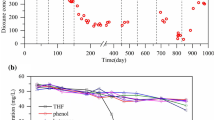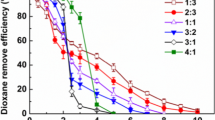Abstract
A mixed culture with the ability to aerobically biodegrade 1,4-dioxane in the presence of tetrahydrofuran (THF) was enriched from a 1,4-dioxane contaminated aquifer. This consortium contained 3–4 morphologically different types of colonies and was grown in mineral salts media. Biodegradation of 1,4- dioxane began when THF concentrations in batch experiments became relatively low. No biodegradation of 1,4-dioxane was observed in the absence of THF and the measured cell yield was similar during degradation of 1,4-dioxane with THF or with THF alone. However, when the consortium was grown in the presence of 14C-1,4-dioxane plus THF, 2.1% of the radiolabeled 1,4-dioxane was present in the particulate fraction. The majority of the 14C (78.1%) was recovered as 14CO2, while 5.8% remained in the liquid fraction. This activity is interesting since the non-growth substrate is mineralized, yet only minimally assimilated into biomass. Using THF as the growth substrate, 1,3-dioxane, methyl t-butyl ether, ethyl t-butyl ether and t-amyl methyl ether.
Similar content being viewed by others
References
Abe A (1999) Distribution of 1,4–dioxane in relation to possible sources in the water environment. The Sci. of the Tot. Environ. 227: 41–47
Alexander M (1965) Biodegradation: problems of molecular recalcitrance and microbial fallibility. Adv. Appl. Microbiol. 7: 35–80.
Alexander M (1973) Nonbiodegradable and other recalcitrant molecules. Biotechnol. and Bioeng. 15: 611–647
Alvarez-Cohen L & McCarty PL (1991) Effects of toxicity, aeration, and reductant supply on trichloroethylene transformation by a mixed methanotrophic culture. Appl. and Environ. Microbiol. 57: 228–235
American Public Health Assocation, American Water Works Association, Water Environment Federation (1995) Standard Methods for the Examination of Water and Wastewater. 19th edn
Bernhardt D & Diekmann J (1991) Degradation of dioxane, tetrahydrofuran and other cyclic ethers by an environmental Rhodococcus strain. Appl. Microbiol. and Biotechnol. 36: 120–123
Burback, BL & Perry (1993) Biodegradation and biotransformation of groundwater pollutant mixtures by Mycobacterium vaccae. Appl. and Environ. Microbiol. 59: 1025–1029
Burmaster DE (1982) The new pollution: groundwater contamination. Environ. 24: 6–13, 33–36
Chang HL & Alvarez-Cohen L (1995) Transformation capacities of chlorinated organics by mixed cultures enriched on methane, propane, toluene, or phenol. Biotechnol. and Bioeng. 45: 440–449
Chang MK, Voice TC & Criddle CS (1993) Kinetics of competitive inhibition and cometabolism in the biodegradation of benzene, toluene, and p-xylene by two Pseudomonas isolates. Biotechnol. and Bioeng. 41: 1057–1065.
Cowan RM, Morin MD, Sock SM, Grady CPL & Hughes TA (1994) Isolation and identification of microorganisms responsible for 1,4–dioxane mineralization. 94th ASM General Meeting. Abstract Q444
Dalton H & Stirling DI (1982) Co-metabolism. Philosophical Transactions of the Royal Society of London, Serial B 297: 481–496
DeWalle FB & Chian ESK (1981) Detection of trace organics in well water near a solid waste landfill. J. AWWA 73: 206–211.
Fetter CW (1993) Contaminant hydrogeology. Macmillan Publishing Company, New York, NY
Francis AJ, Iden CR, Nine BJ & Chang CK (1980) Characterization of organics in leachates from low-level radioactive waste disposal sites. Nucl. Technol. 50: 158–163
Kelley SL, Aitchison EW, Schnoor JL & Alvarez PJ (1999) Bioaugmentation of poplar roots with Amycolata sp. CB1190 to enhance phytoremediation of 1,4–dioxane. In: A Leeson and BC Alleman (eds), Phytoremediation and Innovative Strategies for Specialized Remedial Applications. The Fifth International In Situ and On-Site Bioremediation Symposium, Vol. 5, No. 6(pp. 139–144). Battelle Press, Columbus, OH
Leadbetter ER & Foster JW (1958) Studies on some methaneutilizing bacteria. Archiv fur Mikrobiol. 30: 91–118
Lesage S, Jackson RE, Priddle MW & Riemann PG (1990) Occurrence and fate of organic solvent residues in anoxic groundwater at the Gloucester landfill, Canada. Environ. Sci. Technol. 24: 559–566
Mills EJ & Stack VT (1954) Biological oxidation of synthetic organic compounds. Proceedings of the 8th Industrial Waste Conference, Vol, 83 (pp. 492–517). Purdue Engineering Experiment Station
Parales RE, Adamus JE, White N & May HD (1994) Degradation of 1,4–dioxane by an actinomycete in pure culture. Appl. and Environ. Microbiol. 60: 4527–4530
Popoola AV (1991) Mechanism of the reaction involving the formation of dioxane byproduct during the production of poly(ethylene terephthalate). J. Appl. Polymer Sci. 43: 1875–1877.
Ress BB, Calvert PP, Pettigrew PA & Barlaz MA (1998) Testing anaerobic biodegradability of polymers in a laboratory-scale simulated landfill. Environ. Sci. Technol. 32: 821–827
Saez PB & Rittman BE (1991) Biodegradation kinetics of 4–chlorophenol, an inhibitory co-metabolite. Res. J. WPCF 63: 838–847
Sock SM (1993) A comprehensive evaluation of biodegradation as a treatment alternative for the removal of 1,4–dioxane. Master of Science Thesis. Clemson University
Taylor SW, Lange CR & Lesold EA (1997) Biofouling of contaminated groundwater recovery well: characterization of microorganisms. Ground Water 35: 973–980
Toxics Release Inventory (1997) Public data release. Office of Pollution Prevention and Toxics. United States Environmental Protection Agency, Washington, D.C
Weimar RA (1980) Prevent groundwater contamination. Water & Wastes Eng
Zenker MJ, Borden RC & Barlaz MA (1999) Investigation of the intrinsic biodegradation of alkyl and cyclic ethers. The Fifth International In Situ and On-Site Bioremediation Symposium. Battelle Press. Cincinnati, OH
Author information
Authors and Affiliations
Rights and permissions
About this article
Cite this article
Zenker, M.J., Borden, R.C. & Barlaz, M.A. Mineralization of 1,4-dioxane in the presence of a structural analog. Biodegradation 11, 239–246 (2000). https://doi.org/10.1023/A:1011156924700
Issue Date:
DOI: https://doi.org/10.1023/A:1011156924700




